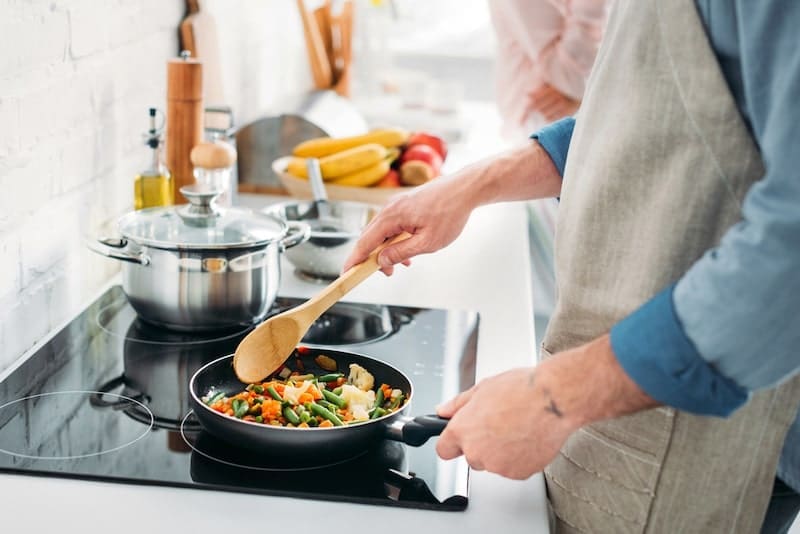Cooking skills everyone should know are just like budgeting and houseplant care—they require knowledge and experience. Cooking school is fun, but who has time? We’ve simplified cooking into five essential skills to make your meals easier and tastier. Learn these five important culinary skills, no matter your experience level.
Learn to Boil
What could be more fundamental than filling a pot, turning it on high, and letting the water boil? Lots of excellent meals may be made by boiling water and steaming or poaching. You can prepare weeknight pasta, basic stocks and broths, poached eggs for breakfast, and fish for dinner parties by mastering boiling. Weeknight sides might include hard-cooked eggs or steamed broccoli and sweet potatoes. Can we forget soup? Cheap, comforting soup and beans need boiling.
What to know about boiling: Three kinds of boils are rolling, sluggish, and simmering. Rumbling, bubbling characterize a rolling boil at 212 F. Pasta with hard-cooked eggs are usually cooked at a rolling boil. Tips: Salt your pasta pot after boiling, since water boils quicker without it. Most broth and stock are made with a slow boil at 205 F. Simmering is 205–190 F. How to stew dry beans and make rich, meaty braises.
Proper Onion Cutting
Because onions, carrots, and chicken cutlets cook more evenly when cut uniformly, basic knife skills make cooking quicker and simpler. Because onions are the most common aromatic for anything from chili to Christmas roasts, they are often used to demonstrate knife skills. However, onion-cutting techniques apply to other produce: Remove the stem and peel, cut into manageable pieces with a flat stable side, and then cut into smaller pieces carefully.
To chop an onion, start by cutting off its top but keep the root. This makes chopping easier. Peel the onion. Cut it in half from top to bottom. Take one half and put the cut side down. The top should be in line with the knife. Slice the onion into ¼-inch wide pieces. Don’t cut all the way to the root. Cut down across these slices. Then turn the onion 90 degrees. Cut it again to make it fine. Do this one half at a time.
Salt while you cook
Why learn to salt over time? The answer behind why restaurant food tastes better than home-cooked cuisine: At practically every stage, chefs season food. That, with fat and acid, produces delicious food. Learning about salt, when to use it, and how to season food before cooking and while serving is the simplest approach to improving your cuisine.
Use different salts when you cook. Keep kosher, fine, and flaky salt at home. Use kosher salt for most cooking. It’s good for dry brining and preserving. Most recipes need kosher salt. Choose one brand of kosher salt. Diamond Crystal and Morton’s are different. Use fine salt for baking. It mixes well into the dough. Use flaky salt to finish dishes. It looks and tastes great on cookies.
Make Basic Vinaigrette
“Vinaigrette” doesn’t signify green salads in this vital culinary technique. It will assist, but making a dressing will teach you all you need to know about emulsions to produce more complicated sauces like aioli and balance fat and acidity.
Make a simple vinaigrette. Use equal parts oil and vinegar, not 3 parts oil to 1 part vinegar like in French dressing. Add honey or mustard to taste. Your use decides the best mix. For roasted or grilled veggies, make it sweet and balanced. For bitter greens, make it more acidic.
Roast Vegetables for Better Flavor
Everything tastes better roasted! Your oven can caramelize and crisp veggies with heat and oil. Roasting is a fast method to prepare a lot of food, use up your vegetable drawer, and make numerous sheet pan dinners. Be careful: Too low a temperature can steam or stick veggies, while too high will burn carrots before they’re done.
Roast in an oven at 375–425 F. Fully heat the oven. Stops sweet potatoes from sticking. Before baking, wash, peel, and slice vegetables. Use two sheets to cook quicker. Quick-cooking vegetables on one, harder ones on the other. Dress vegetables with canola or olive oil. Season too. Use a tablespoon of oil and half a teaspoon of salt per pound of vegetables. Salt may be added subsequently. Start roasting vegetables. Flip them after 10–12 minutes. Roast until well browned.
Bonus Skill: Food Safety Fundamentals
Food safety is simple. It’s about keeping food safe, avoiding mixing certain foods, and making sure food is cooked and stored right.
For safe storage, keep your fridge and freezer at the right temperatures. Food should stay cool enough to stop bacteria from growing. Use a thermometer to check. Keep food below 40 F in the fridge. Keep the freezer below 0 F.
Raw meats and eggs should be kept apart from cooked meals to prevent contamination. Use different knives and cutting boards for raw meat. Always clean them well after use. Don’t eat raw batter or dough.
When cooking, use a thermometer to check if food is done. Cool and store leftovers quickly to keep them safe.
You can get better at cooking by practicing simple skills and by buying good restaurant supplies. McDonald Paper & Restaurant Supplies is a top choice for restaurant supplies. This store is known for its wide range of restaurant and catering supplies for the culinary and hospitality sectors. McDonald Paper & Restaurant Supplies is a vital resource for culinary workers looking to improve efficiency and service.


